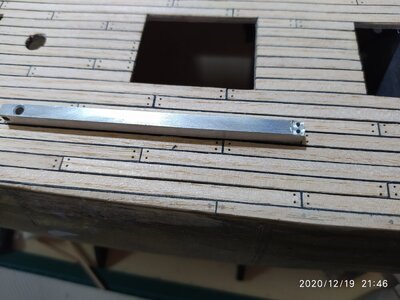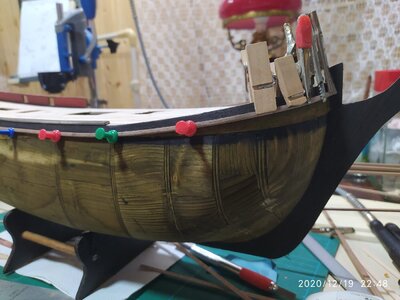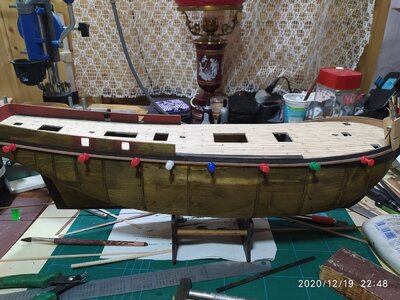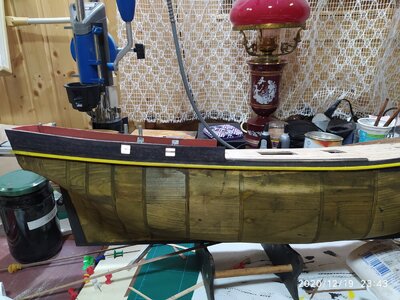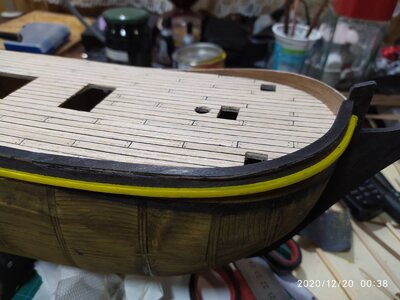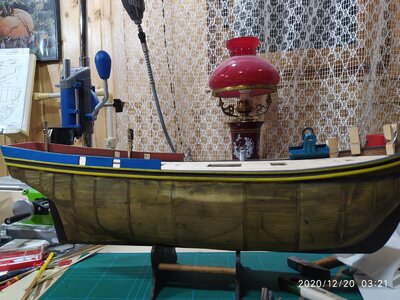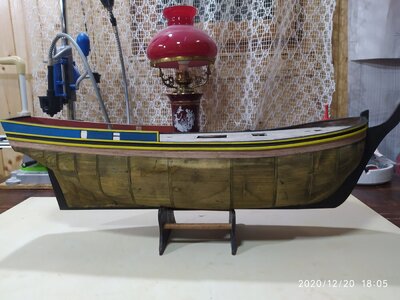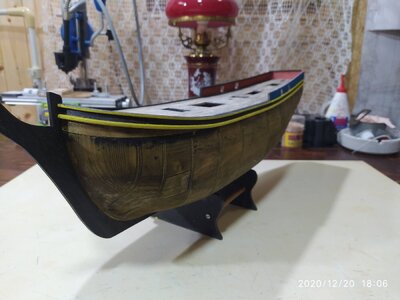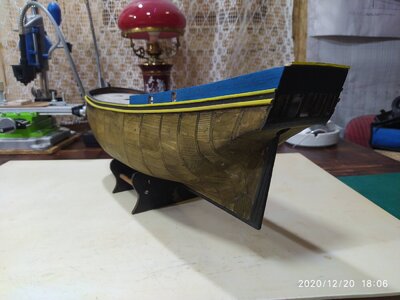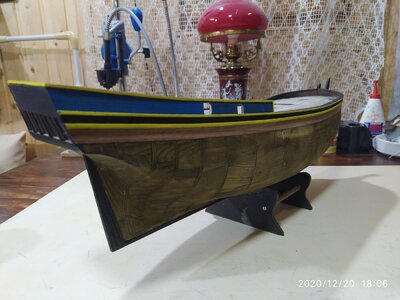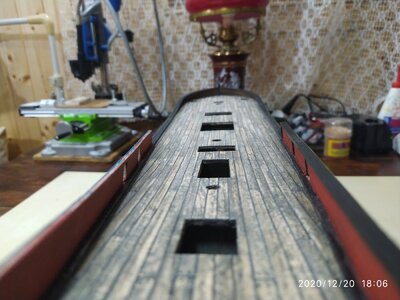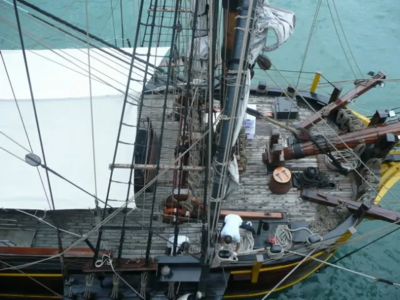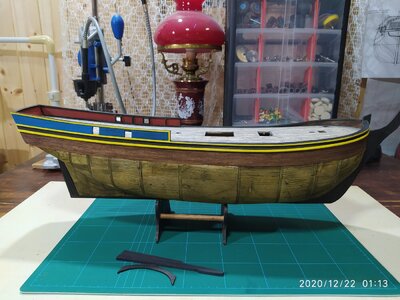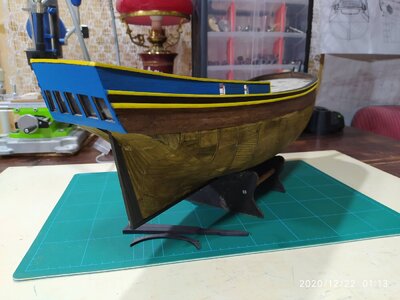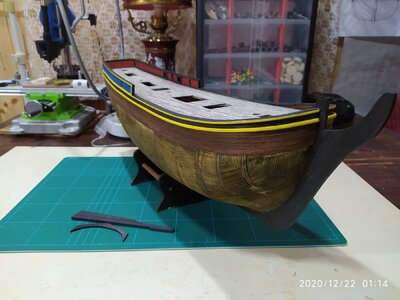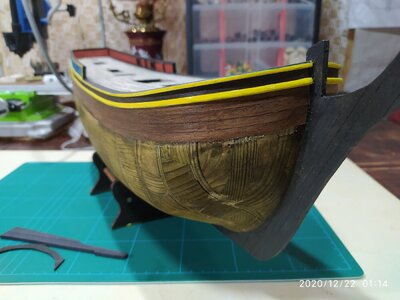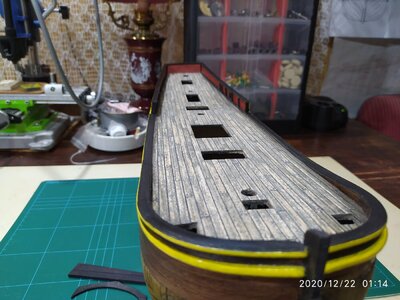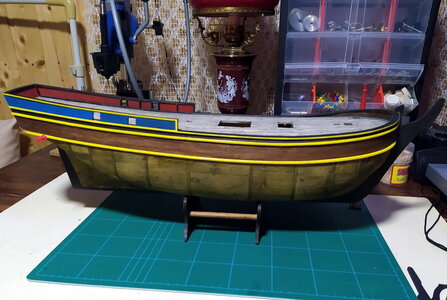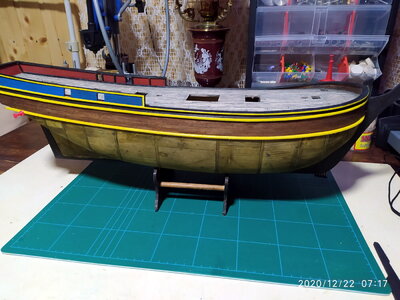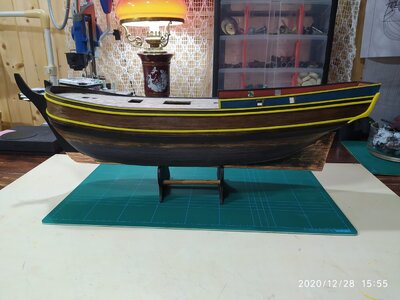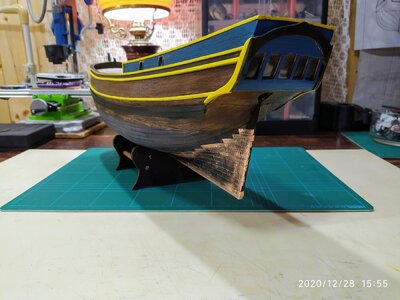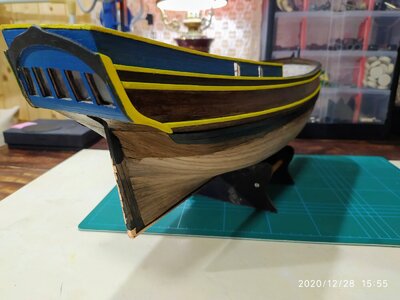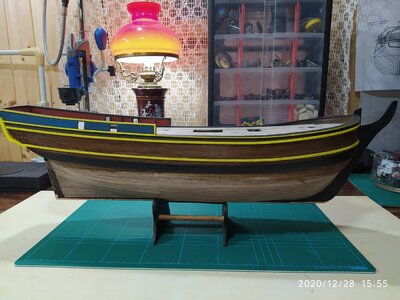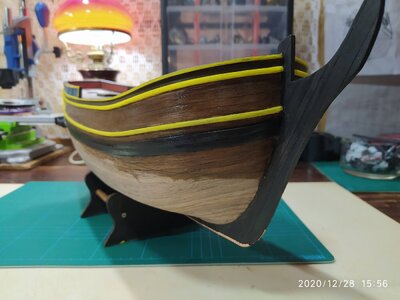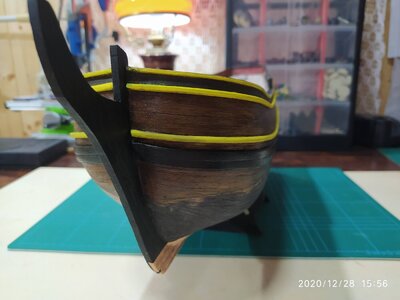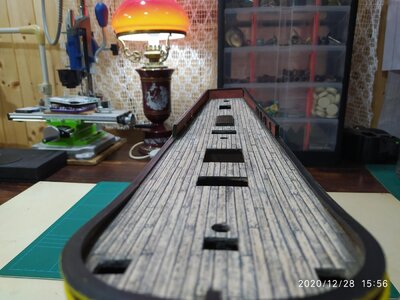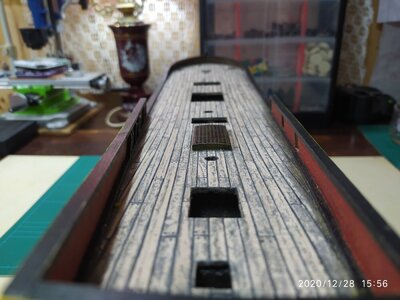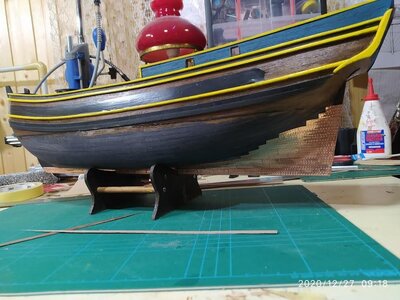Very good progress, Solajic. I am impressed with the way you made\shape the hull ready to accept the final planking. From the above photos, you can really see smooth and even shape lines from Stern to Bow. Also, I like the way you represent the caulking on the deck. Keep updating often. 
-

Win a Free Custom Engraved Brass Coin!!!
As a way to introduce our brass coins to the community, we will raffle off a free coin during the month of August. Follow link ABOVE for instructions for entering.
-

PRE-ORDER SHIPS IN SCALE TODAY!
The beloved Ships in Scale Magazine is back and charting a new course for 2026!
Discover new skills, new techniques, and new inspirations in every issue.
NOTE THAT OUR FIRST ISSUE WILL BE JAN/FEB 2026
You are using an out of date browser. It may not display this or other websites correctly.
You should upgrade or use an alternative browser.
You should upgrade or use an alternative browser.
HMS Bounty 1:60 scale scratch build log update:
Deck planking is finished. Now I have to decide should I leave it in this color tone or should I apply some weathering giving it a just a bit darker and a bit grayish tone before sealing it with transparent acrylic stain with wax. Somehow, I tend to do weathering of the deck to get greyish washed look of the deck.
Now the question I am making to myself is - what kind of trenails to put on the planks... I am bit worried that wrong of this step since it could either improve or damage the overall look of the planked deck. I would probably have to make some kind of a jig so the marking of trenails is repetitive with the same accuracy and aligning ... I must search for the most practical solution.... If you have some ideas , you are welcome to share it with me
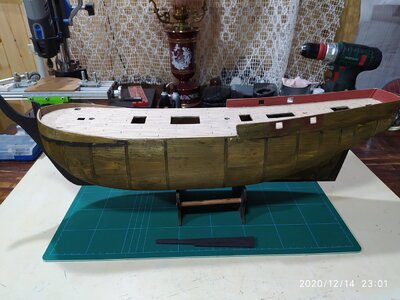
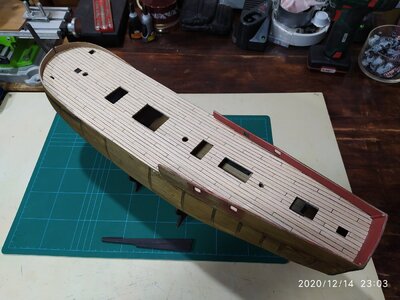
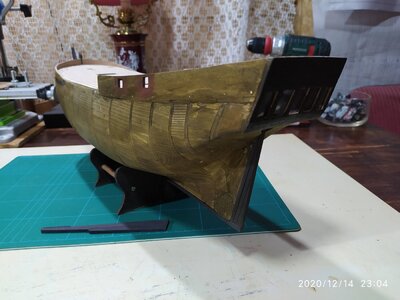
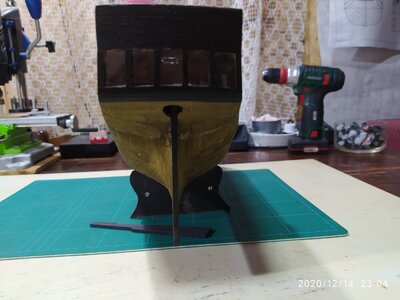
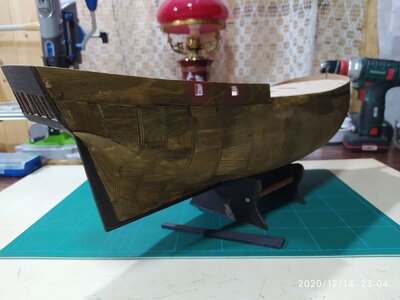
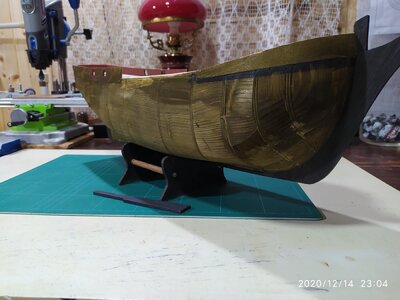
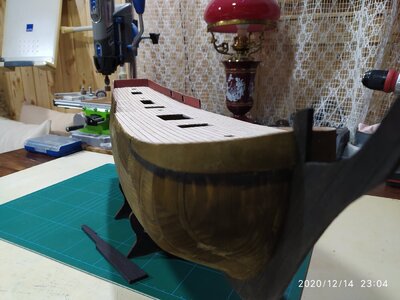
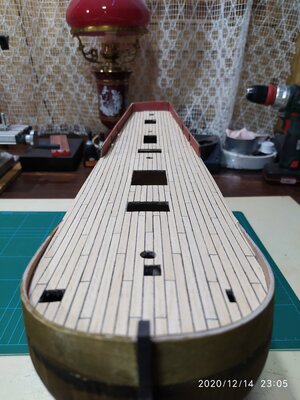
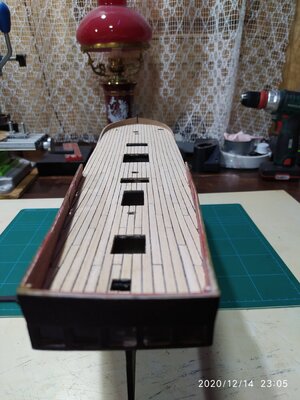
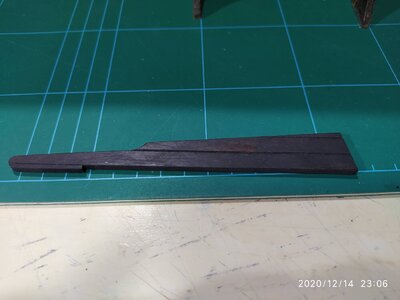
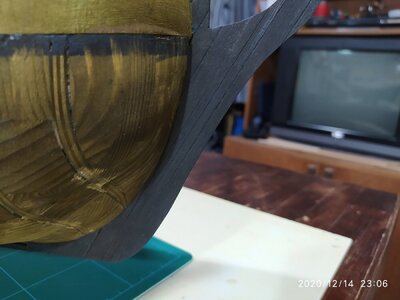
I don't think that any real deck of an sailing ship from 15th to 18th century was so light colored and clean as usually presented in many models. So I think that I shall chemically threat the wood to get something like this :
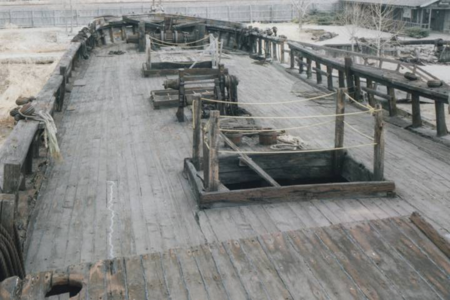
Deck planking is finished. Now I have to decide should I leave it in this color tone or should I apply some weathering giving it a just a bit darker and a bit grayish tone before sealing it with transparent acrylic stain with wax. Somehow, I tend to do weathering of the deck to get greyish washed look of the deck.
Now the question I am making to myself is - what kind of trenails to put on the planks... I am bit worried that wrong of this step since it could either improve or damage the overall look of the planked deck. I would probably have to make some kind of a jig so the marking of trenails is repetitive with the same accuracy and aligning ... I must search for the most practical solution.... If you have some ideas , you are welcome to share it with me











I don't think that any real deck of an sailing ship from 15th to 18th century was so light colored and clean as usually presented in many models. So I think that I shall chemically threat the wood to get something like this :

Last edited:
Hello Solajic, At the scale of 1:60 treenails plugs (they are actually wooden plugs, not actual treenails) would be size about 3 ~3.5mm. It will be challenging to make wooden dowels of such size. In such scales, I usually drill the holes first. Then, insert & twist lightly very sharp pencil lead, making sure not to enlarge the holes. Last use the wood putty to close the holes. Once dry, scape out the excess. This method is very good, IMHO, if you decide to weather the desk, the wood putty accepts stain. Here are some of my test samples. I use Elmer's wood putty on the hornbeam timber. The size of the holes 4.0mm
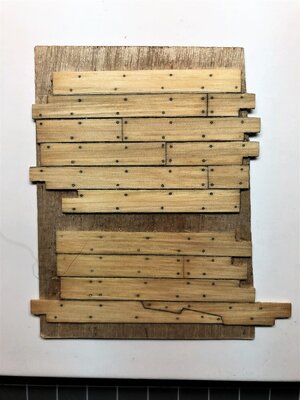
Another method is just to drill the holes and leave them like this. It will look much better, IMHO, than any oversized treenails plug. One of the recent methods I use in my Alert build - is brass treenails. This is straight forward: drill the hole, insert the wire, and cut flush. The disadvantage of this method, however, if you have your decking material as 'soft' wood. When you will perform the final sanding, the timber around the treenail will be sanded more than the actual wire and such making the pit.
All and all the choice is yours as long as you accept it!

Another method is just to drill the holes and leave them like this. It will look much better, IMHO, than any oversized treenails plug. One of the recent methods I use in my Alert build - is brass treenails. This is straight forward: drill the hole, insert the wire, and cut flush. The disadvantage of this method, however, if you have your decking material as 'soft' wood. When you will perform the final sanding, the timber around the treenail will be sanded more than the actual wire and such making the pit.
All and all the choice is yours as long as you accept it!
Thank you Jim your input is very helpful and saving me some dilemmas. I shall try test make these methods on scrap wood and scrap planks than decide. Tell me, do you use some kind of drilling jig to get such an accurately positioned holes? I cannot imagine to be equally accurate drilling a few hundreds of tinny holes , and I am afraid that it might become messyHello Solajic, At the scale of 1:60 treenails plugs (they are actually wooden plugs, not actual treenails) would be size about 3 ~3.5mm. It will be challenging to make wooden dowels of such size. In such scales, I usually drill the holes first. Then, insert & twist lightly very sharp pencil lead, making sure not to enlarge the holes. Last use the wood putty to close the holes. Once dry, scape out the excess. This method is very good, IMHO, if you decide to weather the desk, the wood putty accepts stain. Here are some of my test samples. I use Elmer's wood putty on the hornbeam timber. The size of the holes 4.0mm
Another method is just to drill the holes and leave them like this. It will look much better, IMHO, than any oversized treenails plug. One of the recent methods I use in my Alert build - is brass treenails. This is straight forward: drill the hole, insert the wire, and cut flush. The disadvantage of this method, however, if you have your decking material as 'soft' wood. When you will perform the final sanding, the timber around the treenail will be sanded more than the actual wire and such making the pit.
All and all the choice is yours as long as you accept it!
Last edited:
Before starting planking I decided to give a try and make home wood strips /plank cutting device
I purchased this Fellowes Fusion A3 paper cutter which required just a small modification for my purpose- I added 40x40mm Aluminum L-profile to make fix stop for the desired plank width and that is all.
All cuts are perfect far better than any manual cutting I have done before, and it is time saving- approx 10-15 times faster than manually cutting in a jig. Investment worth of the money.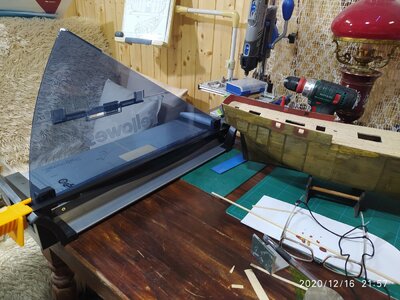
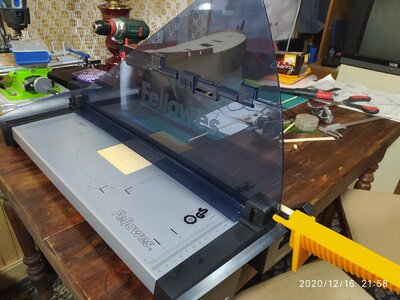
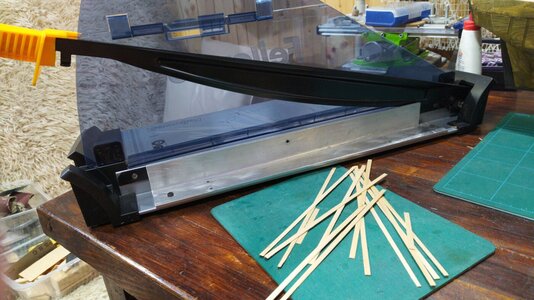
I purchased this Fellowes Fusion A3 paper cutter which required just a small modification for my purpose- I added 40x40mm Aluminum L-profile to make fix stop for the desired plank width and that is all.
All cuts are perfect far better than any manual cutting I have done before, and it is time saving- approx 10-15 times faster than manually cutting in a jig. Investment worth of the money.



Interesting method for hull. What did you use for your window material?After fairing of the hull is completed, I stained it with water based stain of "green walnut". That small trick is done to efficiently hide any imperfection in planking which might lead to tinny white streaks if any small gap between planks appear. (usually I have no such gaps but... better save than sorry)
The water-stop bow bulwarks is cut out from 2mm avio plywood which was soaked in hot water for 10 minutes and than easily bent to the shape. Temp-mounted on the bow, fixed until it completely dried out and getting the shape.
After that, bulwarks were removed, a narrow strip 2mm depth was cut out from the bow to accommodate these front-end pieces. Beak top is also carved in tinny slots 2mm wide, 0.5mm depth so the bulwarks sit there and got secured in place by the beak.
My assistant below the table approved the operationView attachment 198702View attachment 198703View attachment 198704View attachment 198705View attachment 198706View attachment 198707View attachment 198708View attachment 198709View attachment 198710View attachment 198711View attachment 198712View attachment 198713View attachment 198714View attachment 198715View attachment 198716
Thanks, Solajic. I don't use any specialty jigs. I usually use a cardboard strip to draw lines first. Then, I use a very sharp awl and poke marks. Put the drill bit to the mark and only then turn on the moto-tool. For this job I use a rotary tool with a pedal, both hands are freeThank you Jim your input is very helpful and saving me some dilemmas. I shall try test make these methods on scrap wood and scrap planks than decide. Tell me, do you use some kind of drilling jig to get such an accurately positioned holes? I cannot imagine to be equally accurate drilling a few hundreds of tinny holes , and I am afraid that it might become messy
I saw somewhere a method where a large pin is used to make the hole and then dipped in India ink and reinserted into the hole. This leaves a black mark like the nails would.Hello Solajic, At the scale of 1:60 treenails plugs (they are actually wooden plugs, not actual treenails) would be size about 3 ~3.5mm. It will be challenging to make wooden dowels of such size. In such scales, I usually drill the holes first. Then, insert & twist lightly very sharp pencil lead, making sure not to enlarge the holes. Last use the wood putty to close the holes. Once dry, scape out the excess. This method is very good, IMHO, if you decide to weather the desk, the wood putty accepts stain. Here are some of my test samples. I use Elmer's wood putty on the hornbeam timber. The size of the holes 4.0mm
View attachment 199278
Another method is just to drill the holes and leave them like this. It will look much better, IMHO, than any oversized treenails plug. One of the recent methods I use in my Alert build - is brass treenails. This is straight forward: drill the hole, insert the wire, and cut flush. The disadvantage of this method, however, if you have your decking material as 'soft' wood. When you will perform the final sanding, the timber around the treenail will be sanded more than the actual wire and such making the pit.
All and all the choice is yours as long as you accept it!
That’s a great nail hole jig.View attachment 200257View attachment 200258View attachment 200259View attachment 200260View attachment 200261Simple jig to properly drill equidistant holes for trenails ... Bulwarks are planked and painted, first stringer attached, painted to Bounty colors.

I used those nice pretty stiff foils that are usually used as transparencies for overhead projectors. I cut out the foil, carved out one layer of plywood from the back side and glued foil in that carved place.Interesting method for hull. What did you use for your window material?
Nice to have references like this to compare to your build.
With the appearance of the deck it is really a question of personal taste.This is the picture of Bounty replica... it seems that I quite good resembled the look and the color of the deck on my model
View attachment 200347
The photo you show as a reference is the so called HongKong Bounty Chi Ming, originally from Australia, which was there used a pleasure trip ship

I do not know, if it is the best, to use such a ship as a reference, if you want to build a ship model of the original HMAV Bounty.
I think also, that the deck on your photo was still wet from rain, also possible to recognize, that the crew has still the tent as protection against rain
As I mentioned in the beginning it is a question of personal taste, but for me the deck of your model is too dark and too weathered.
The original Bounty was a Her Majesty's Ship , so I guess that the deck was usually well cleaned. Only a suggestion.....
Or you show her after a rainfall in Tahiti
Yeah you might be right... Well I didn't use this replica as a reference.. actually I just stumbled upon that image since there are not much pictures showing the deck from above.With the appearance of the deck it is really a question of personal taste.
The photo you show as a reference is the so called HongKong Bounty Chi Ming, originally from Australia, which was there used a pleasure trip ship
View attachment 200552
I do not know, if it is the best, to use such a ship as a reference, if you want to build a ship model of the original HMAV Bounty.
I think also, that the deck on your photo was still wet from rain, also possible to recognize, that the crew has still the tent as protection against rain
As I mentioned in the beginning it is a question of personal taste, but for me the deck of your model is too dark and too weathered.
The original Bounty was a Her Majesty's Ship , so I guess that the deck was usually well cleaned. Only a suggestion.....
Or you show her after a rainfall in Tahitiafter Fletcher took command
You are right absolutely, the weathering and color schemes are mostly the question of the personal taste and I am the old school modeler who like to build models realistically weathered as they were just pulled out of the ocean and put in the shelve
Yet from my personal experience (and I saw many ships and were on board on some when I was younger, decks are very rarely as fancy, light colored polished, varnished, as the most of the modelers represent them. Except of modern fancy expensive yachts and cruisers all of the ship decks I have seen in the real life looked mostly as those shown in photos below. I doubt that 18th century ship had better looking more polished deck, so I decided to make it as I expected to see on the 18th century ship which traveled over 12 months in the tropic waters exposed to all elements. At least that is my impression or expectation what could be seen.
At the time , tall ships were built from 12-24 months and even when they come out of the shipyard, the deck was exposed to the elements. No cleaning could restore the fresh whiteness of the freshly cut timber.
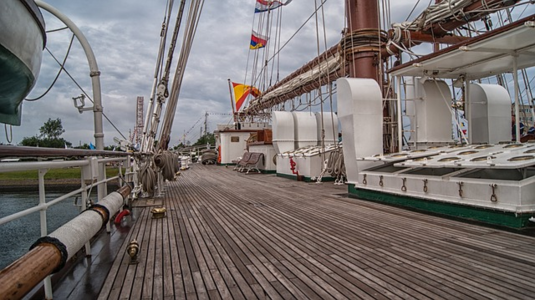

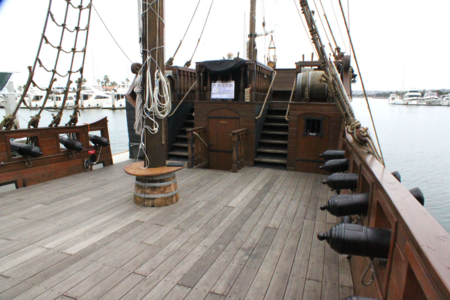
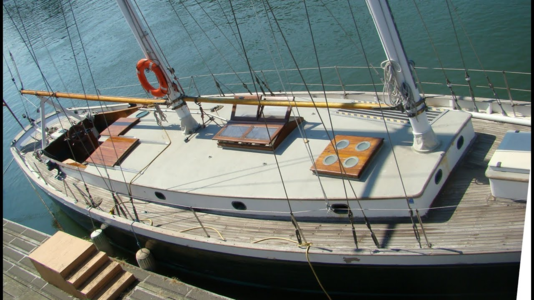
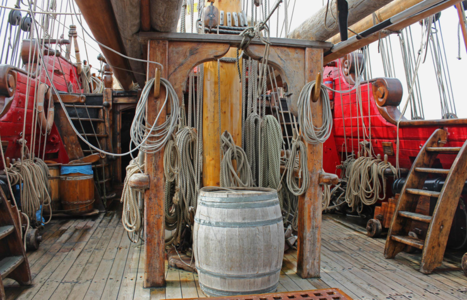
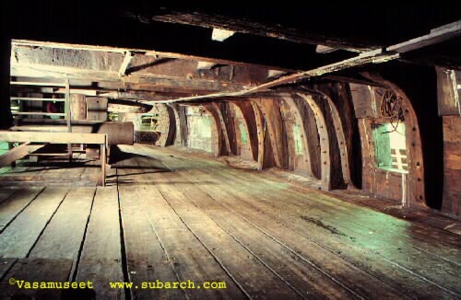
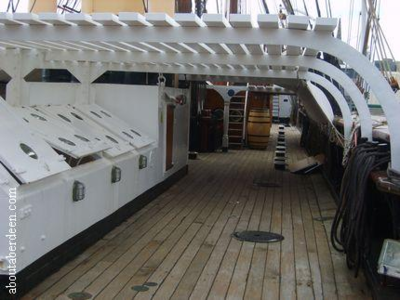
Last edited:
I agree, a varnished/oiled/polished deck would be a nightmare to walk on, but my God it looks so nice like that. I think I will stay with making my ships look as nice as I can and forego the historical accuracy for modern day beauty. I am completely amazed by some of the weathering techniques I've seen in this forum. Not for me, I want my models looking like they did right out of the shipyard.Yeah you might be right... Well I didn't use this replica as a reference.. actually I just stumbled upon that image since there are not much pictures showing the deck from above.
You are right absolutely, the weathering and color schemes are mostly the question of the personal taste and I am the old school modeler who like to build models realistically weathered as they were just pulled out of the ocean and put in the shelve
Yet from my personal experience (and I saw many ships and were on board on some when I was younger, decks are very rarely as fancy, light colored polished, varnished, as the most of the modelers represent them. Except of modern fancy expensive yachts and cruisers all of the ship decks I have seen in the real life looked mostly as those shown in photos below. I doubt that 18th century ship had better looking more polished deck, so I decided to make it as I expected to see on the 18th century ship which traveled over 12 months in the tropic waters exposed to all elements. At least that is my impression or expectation what could be seen.
At the time , tall ships were built from 12-24 months and even when they come out of the shipyard, the deck was exposed to the elements. No cleaning could restore the fresh whiteness of the freshly cut timber.
View attachment 200560View attachment 200574View attachment 200561View attachment 200562View attachment 200563View attachment 200564View attachment 200565


Looking really nice and clean lines, very nice paint job. My Bluenose is a bit raggedy with some of the detail lines. I might cheat and replace one of the fine detail lines with pinstripe material. I just can't seem to get it perfect.Planking of the hull continue. So far it is a breeze on I came to the main wales.
View attachment 200567View attachment 200568View attachment 200569View attachment 200570View attachment 200571View attachment 200572View attachment 200573



